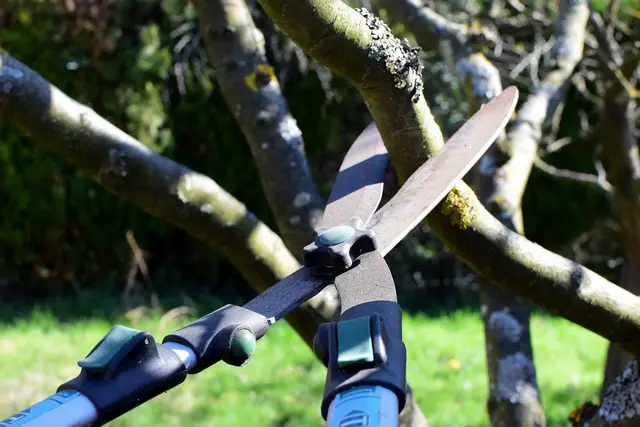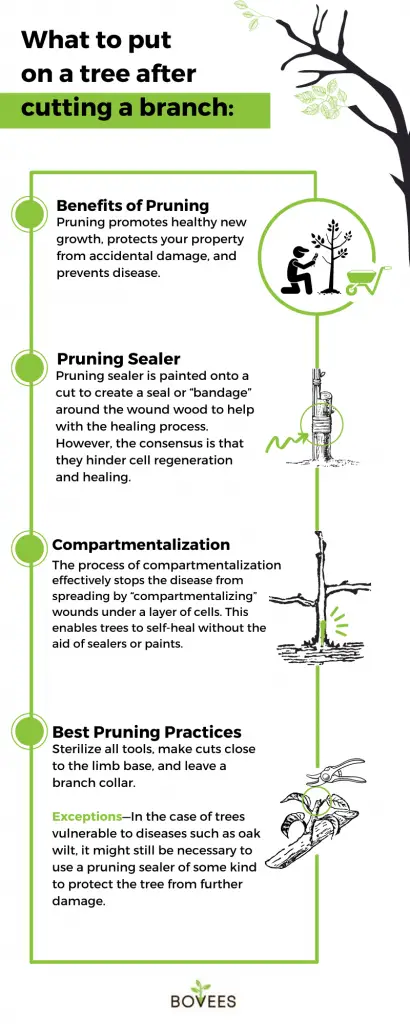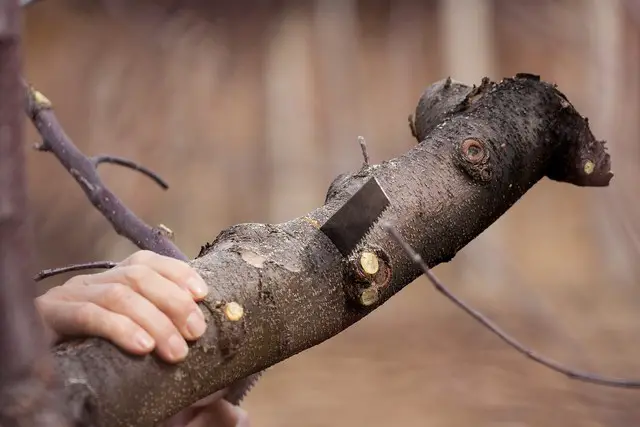Last Updated on September 5, 2022 by Grow with Bovees
Once upon a time, it was common practice to use a tree wound sealer when trimming trees.
Painting on a tree pruning sealer to seal the limb after cutting was considered best practice and recommended by professional arborists, horticulturists, and landscape gardeners alike.

However, this is no longer the case.
The painting of tree limbs and branches with tree wound paint, or sealant, has been very much consigned to the realms of myth and bad practice.
So let’s take a look at what has replaced it and what to put on a tree after cutting a branch.
Why Prune?
Before getting onto the question of treating tree branches, it’s worth summarizing the benefits of pruning, which are many.
Firstly, it significantly reduces the risk of trees accidentally damaging your property. Then there’s also the question of regeneration. Pruning trees promotes new growth, not forgetting the health implications. Pruning trees can be a significant deterrent to pests and prevent potentially damaging infestations and tree diseases.
These are all good reasons to continue the practice. But what is wrong with getting out the pruning sealer at this point?

Should I Use Pruning Sealer on a Tree Wound? If So, When Do I Use Tree Sealer?
Pruning sealer, or pruning paint, is simply a petroleum-based waterproof product that is “painted” onto the exposed area of a limb or branch after it has been pruned.
The idea is that the application works as a kind of “bandage”, which once painted on allows the tree to heal underneath it. It does this by working as protection from excessive sap loss, insects, and fungi—in short, preventing decay.
At least that was what the majority of experts used to think…
So What Has Changed Regarding Pruning Wounds?
Scientific research conducted by the plant pathologist Alex Shigo, into compartmentalization, in the late 70s called into question this accepted practice. This, along with later work corroborating Shigo’s findings, has led to an entirely new approach.
What Is Meant By Compartmentalization?
The process of compartmentalization makes it possible for trees to have hundreds or even thousands of wounds and yet still be alive. Separating the wounds, by effectively “closing down, or compartmentalizing” the site of the wound, it prevents disease spreading further. This happens within the cells, allowing for a natural healing process, which requires no sealant.
Should I Seal a Tree Wound – If So, How Should It Be Done?
Shigo found that rather than helping, tree pruning sealer actually hindered the process of natural healing by sealing in potentially problematic moisture, providing nourishment for pathogens, and preventing the vital and much healthier recovery process of compartmentalization.
Compartmentalization is a process of self-healing in which trees form a series of walls around the wound wood. These walls are made up of cells and prevent the spread of disease, as well as acting to speed up the natural healing process. Much like a scab works on human skin.
Because of this regeneration process, it is often best that a fresh cut should be left to heal naturally after pruning instead of being dressed or treated in any artificial way.

What Are Best Practices In Pruning?
Now that we have established that not sealing wound wood and allowing pruning wounds to heal naturally is better all-around, what are the best practices?
- All pruning tools should be sterilized before and after any tree cutting. That applies regardless of the time of year you are pruning or the type of trees you are working on.
- Pruning cuts should be made at the base of the limb and left as smooth as possible. Leave a small collar or branch collar of wood at the base.
- Timing is critical in best practices. Trees are best pruned in late winter, as close to “bud break” as possible. This facilitates the faster growing over of pruning cuts when spring eventually arrives.
- Proper disposal of limbs and branches is essential. Tree pruning should not lead to any spreading of disease.
Tree pruning, like any surgery, is a delicate operation.
By following the above, unwanted complications or infections can be avoided.
Are There Any Exceptions To This New Approach?
If disease is prevalent, then yes. For example, oak trees are an exception because of the susceptibility of oak trees to the disease oak wilt. The disease is spread from tree to tree by Nitidulid beetles which are attracted to tree sap.
Because of this, it is recommended practice to seal cut tree limbs with a wound dressing as quickly as possible before the beetles catch a whiff of that sweet-smelling sap.
A wound dressing can be used in such cases, but ordinary paint works just as well. That said, applying wound solution to pruned branches should only be necessary for the first three or four days after an operation.
In other words, one coat should be more than enough to keep those disease-spreading beetles at bay.
In fact, in the 24 states where oak wilt is a concern, including Texas, pruning is positively discouraged during spring. Considering the lasting damage that can be done by this disease, it’s easy to see why.
When pruning your maple tree, just make sure the pruning shears are sterilized before use.
FAQ
Should You Seal a Tree Branch After Cutting With Wound Paint?
The recommended practice used to be to seal cuts and wound wood in tree sealer. The idea was that pruning sealer would prevent decay and speed up the healing process.
However, more recent research has overturned this idea, and it’s now believed that rather than help, pruning sealers actually hinder the natural healing of a tree cut or wound.
In other words, instead of sealing out, they are sealing in disease and decay, as well as preventing the millennia-old process of self-healing known as compartmentalization.
In most cases, it’s simply best to let trees heal on their own.
How Do You Treat Tree Wounds?
The process of compartmentalization, which effectively stops disease from spreading by containing or compartmentalizing wounds under a layer of cells, allows trees to heal on their own. This process is best left to take its course. When pruning your dogwood tree, it will thank you for not using a sealant afterwards.
Even though there are a plethora of products as wound “dressings” on the market, they are, for the most part, completely unnecessary.
Should You Paint Over Cut Tree Limbs?
The common consensus is no; you should not. Wound paints and pruning sealers are not only unnecessary to the healthy and safe healing of a tree cut but could also be counterproductive and potentially harmful. This, coupled with the fact that they are not the most eco-friendly of products, means that, for the most part, you should steer well clear.
That is unless you live in Texas and you happen to be pruning an oak. Then, by all means, use pruning paint. It’s either that or running the risk of oak wilt. So you might not have much of an option, save for not pruning at all.
What Is Tree Pruning Sealer?
Pruning sealant is usually petroleum-based, while darker varieties can contain asphalt. As well as being potentially harmful to humans, pruning sealers are thought to hinder the cell regeneration and healing of tree wounds.
Don’t More Natural, Less Harmful Products Exist?
While more natural, less harmful products do exist—made from a variety of ingredients, such as collagen, pectin, aloe vera, etc.—there isn’t any hard and fast scientific proof to support the fact that any of them are actually beneficial to a tree wound.
Final Word on Should I Seal a Tree Wound?
So there you have it—what to put on a tree after cutting a branch. The answer, for the most part, seems to be nothing at all. Remember if the cutting is done at the correct time, and following all the best practices, then trees should self-heal perfectly well without the need for any help.
Your job just got a little bit easier.
